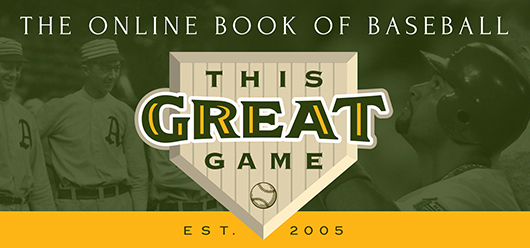THE TEAMS
The Marlins’ Five Greatest Hitters
 Giancarlo Stanton (2010-17)
Giancarlo Stanton (2010-17)
Few sluggers in recent times have turned opposing pitchers white just by showing up to the plate as has the 6’6”, 240-pound Stanton, who beheld prodigious tape-measure power and, at age 28, already was tops on the Marlins’ all-time home run list—and by a wide margin.
Introduced to the baseball world as Mike Stanton, the Los Angeles-area native had his first name formally changed to Giancarlo in 2012 because that’s the name his mother gave him—but ‘Mike’ had stuck since his elementary school classmates found ‘Giancarlo’ too hard to pronounce. (That he might be confused for long-time reliever Mike Stanton, who retired a few years before Giancarlo’s debut, apparently had nothing to do with it.) The more exotic moniker seemed more appropriate for his extraordinary feats of hitting; no ballpark is too big. Stanton’s name appeared regularly and repeatedly on Top 10 lists for the longest home runs hit every year; the very longest he’s ever hit occurred in 2016 when he launched a 505-foot blast at Denver’s Coors Field. But even that tape-measure shot came up short to the 510-foot drive he nearly hit completely out of Minnesota’s Target Field during the 2014 Home Run Derby. When he won the Derby in 2016 at San Diego, 20 of the 21 farthest-hit balls had his name on it.
For much of his career, staying healthy proved to be Stanton’s biggest challenge, as he missed 240 games to injury over his first six seasons. In a 2017 MVP effort, Stanton finally showed the kind of awe-inspiring numbers he could rack up playing pain-free for a full season when he belted 59 homers with 132 runs batted in. Stanton just missed his goal of 62 to surpass Roger Maris’ 1961 total, publicly intimating that Maris’ 61 represented the true (read: steroid-free) season standard.
Even when handicapped with injury, Stanton managed to forge two home run crowns. He led the NL in 2012 with 37 despite playing in only 123 games, and matched that figure (pacing the circuit again) two years later even after an early exit to the season when hit in the jaw from a pitch thrown by Milwaukee’s Mike Fiers.
Two years ahead of free agency, Stanton inked a monumental 13-year, $325 million contract with the Marlins that went down as the largest guaranteed deal in pro sports history. While at first glimpse the pact seemed to be a surprise move by a Marlins front office notorious for eschewing large contracts and hoarding every penny of revenue, it would be quickly revealed that Stanton would get the opportunity to opt out of the deal after 2020. All of this would become moot in Miami when, after the 2017 season, new Marlins management desperate to shed payroll sent Stanton to the New York Yankees.
 Hanley Ramirez (2006-12)
Hanley Ramirez (2006-12)
The perennial All-Star was literally dropped into the Marlins’ lap as an obscure, undrafted player dealt to Florida along with three other unknown players (including pitcher Anibal Sanchez) from Boston for Josh Beckett, Mike Lowell and Guillermo Mota following the 2005 season. An instant success in Florida, Ramirez was the most exciting and productive of the Marlins’ bumper crop of rookies in 2006 with a .292 average, 74 extra-base hits and 51 steals to easily nab National League Rookie of the Year honors. Ramirez was just warming up; his power game increased without compromising his other skill sets, and the Marlins soon began to see more value in dropping him from the leadoff spot to third in the order, where his increased slugging numbers could be better maximized within the lineup. Such immense productivity led Marlins owner Jeffrey Loria, notoriously known for his tight-fisted payroll policies, to dust off the team’s checkbook and reward Ramirez with a six-year, $70 million contract, easily the franchise’s largest at the time. Ramirez returned the love when, in the first year of his deal, he became the Marlins’ first batting champion by hitting .342 to lead the NL.
Ramirez was not without his faults. Defensively, he was not the most gifted shortstop, twice leading the NL in errors at his position. Worse, he was prone to clubhouse controversy; in 2010, he knocked heads with manager Fredi Gonzalez following what was perceived to be lackadaisical play; Gonzalez was soon fired, and many suspected that Ramirez had gotten his way because the Marlins were more financially indebted to him. Two years later, Ramirez initially pouted when he was asked to move to third base to accommodate newly signed free agent Jose Reyes; it all became irrelevant when, after a subpar start to the year, he was traded to the Los Angeles Dodgers—the first move in yet another clearinghouse sale perpetrated by Loria. Had he been allowed to stick around another year or so, Ramirez almost certainly would have become the Marlins’ all-time leader in most major offensive categories.
 Miguel Cabrera (2003-07)
Miguel Cabrera (2003-07)
Like Ramirez, Cabrera made an immediate impact for the Marlins after his debut midway through the team’s second championship season of 2003 at age 20. But Cabrera arrived with far more fanfare, getting paid $1.8 million to sign with the Marlins at age 16 after they won a bidding war for his rights.
The son of parents who both played the game, Cabrera actually credits his mother, a former member of the Venezuelan national softball team, for teaching him his swing. She apparently was a good teacher; Cabrera had a sensational debut for the Marlins, becoming only the third player in modern times to hit a walk-off home run in his first major league game. After a solid (if not sensational) rookie showing in the regular season, Cabrera turned it up a notch in the 2003 postseason, hitting .333 with three home runs in the Marlins’ seven-game NLCS triumph against Chicago. In the World Series that followed, the New York Yankees’ Roger Clemens left his calling card when facing Cabrera for the first time in Game Four by knocking him to the ground; Cabrera answered the call by launching a home run off the Rocket several pitches later.
Cabrera wielded a bat that yielded consistently prodigious power and high averages, a combination that led to his evolution as an RBI machine; he knocked in at least 110 runs in his four full seasons in Florida, and his overall collection of numbers placed him in favorable comparisons with some of the game’s greats before turning 25 years of age.
The penurious Loria, knowing full well that he’d have to unload a ton of cash upon Cabrera to keep him, traded him along with star pitcher Dontrelle Willis to Detroit in 2008 for six players—none of whom panned out for the Marlins. Meanwhile, Cabrera continued to pave his road to the Hall of Fame with the Tigers.
 Gary Sheffield (1993-98)
Gary Sheffield (1993-98)
The multi-talented offensive force who was not afraid to speak his mind—and often got punished for doing so—had a relatively pleasant experience with the Marlins, a five-year tenure that would be the longest he would spend for one team during a 22-year career split between eight different teams.
Close to his hometown of Tampa, Sheffield at first begrudged playing for a first-year franchise but soon saw the growth of talent taking place and flourished as a result of it. Being handed the majors’ first annual salary of $10 million, in 1996, didn’t hurt; Sheffield responded with a monster effort that year, hitting .314 while clouting 42 homers with 120 RBIs and a career-high 142 walks. (He also showcased his dark side by leading the NL with five ejections.) A year later, those numbers were nearly halved as Sheffield struggled through a season-long slump exacerbated by a thumb injury, but he recovered to hit .320 with 20 walks and three homers in 16 postseason games to help push the Marlins to their first world title.
The irony of Sheffield’s time with the Marlins is that he came to Florida as a result of a cost-cutting fire sale in San Diego (in shipping off Sheffield, the Padres received an obscure reliever named Trevor Hoffman). Five years later, the Marlins dealt him on to Los Angeles in much the same manner, as Marlins owner Wayne Huizenga lamented over a payroll bubble he had blown too big.
 Dan Uggla (2006-10)
Dan Uggla (2006-10)
After five years of failing to make a dent in the Arizona organization—never advancing past the Double-A level—Uggla was picked up in the Rule 5 draft and, along with fellow rookie Ramirez, made an immediate impression at the plate for the Marlins in 2006, hitting .282 with 27 home runs and 90 RBIs. Though Uggla’s batting average would occasionally wane through his five years at Florida, his power remained remarkably consistent; from 2007-10, he hit anywhere from 31 to 33 homers per year, making him the first second baseman in the history of the game to hit at least 30 in four straight seasons. But Uggla was not all about the homer; he clubbed 49 doubles in 2007, scored at least 100 runs three times in five years, and gradually became more patient at the plate, topping out with 92 walks in 2009.
Uggla’s fielding abilities were not sensational, and such reputation took on a life of its own in 2008 when he became the first player to commit three errors in an All-Star Game.
Following the 2010 season, Uggla was traded to Atlanta when it was apparent that he and the Marlins would not be able to agree on a long-term contract. Uggla left the Marlins as the franchise’s all-time home run leader with 154 but also first in strikeouts with 760—an average of over 150 per year. (Stanton has since blown past him in both departments.)
Miami Marlins Team History A decade-by-decade history of the Marlins, the ballparks they’ve played in, and the four people who are on the franchise’s Mount Rushmore.
The Marlins’ Five Greatest Pitchers A list of the five greatest pitchers based on their productivity and efficiency.
The Marlins’ Five Most Memorable Games A list of five memorable games and other notable personal achievements that have defined the Marlins’ history.




